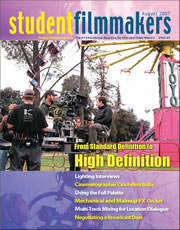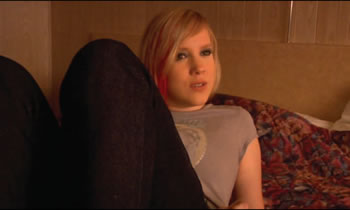HOW-TO |
||||||
Check out this article in the print edition of StudentFilmmakers Magazine, August 2007. Click here to get a copy and to subscribe >>
While the main purpose of shot selection is to get the coverage needed to tell the story, what type of shots used and in which combination really determine the energy and tempo of a scene. Consider the effect of a wide shot on a character or a big close up. Which one is more intimate? What effect does a long take, which tracks in over the shoulder of a character, have? What if that same shot with a track in over the shoulder was done handheld? How intimate and subjective does that shot now become? What energy does handheld bring to the film, and when is it appropriate? While there are no right or wrong answers to these questions, these are questions that need to be asked prior to creating the shot selection. It is often tempting to try to come up with the coolest angle or a plethora of close-ups for cut-aways. But, if the shot selection is not doing anything to help convey the psychology of the story and move it forward, then more often than not, a cool shot can be jarring for the audience and actually bring them out of the film. And, when considering the sequence which the shot selection will be edited, there are those basic rules taught in school such as the 180 and the 30 degree rules which must be understood.
Lighting as an element conveys mood by making it look hard or soft, natural or abstract. Lighting can also define the time of day or season. Maybe more importantly it is crucial in transforming a two dimensional image into what we perceive to be a three dimensional image. As part of an image’s composition, knowing what light fixtures (such as a Fresnel, Xenon or Kino) produce what type of light outputs and properties is crucial in planning the look of the lighting. Take a Kino for example; it puts out a light whose property is a wide spread beam with less fall off. If that is the lighting fixture you choose to go with, under what circumstances would that work best? If you wanted to control it and make it more directional, you would probably use an egg crate. In addition, utilizing gels, diffusion or flags can add those extra touches to the light providing the ability to mold it to a specific purpose. And, if you are out on location, what does an overcast day say in comparison to say the magic hour? But, how does one know what combination of elements will work best in composing the final image? I often wonder how a musician knows what sound they are trying to create. I imagine that one day they wake up with a melody or a tune stuck in their head which compels and guides them into creating the final song. In my experience I have found that the composition of an image works in a similar fashion. Once you have read the script and envisioned the look and feel of the film, you have at the very least some sort of guide. With some trials and tribulations, each element can be locked into place and layered on top of each other to compose a brilliant image.
This article may not be reprinted in print or internet publications without express permission of StudentFilmmakers.com. The above photos may not be copied or reproduced. Check out this article in the August 2007print edition of StudentFilmmakers magazine, page 10 . About StudentFilmmakers Magazine and StudentFilmmakers.com
StudentFilmmakers magazine would like to hear from you! We always welcome and appreciate your Reader Comments. View them here, and send yours to the editorial team today! |


 Saro Varjabedian is a director of photography based in New York and has worked on over twenty films, music videos and corporate videos for various production companies. He has recently finished production on La Chambre de Motel, which he wrote and directed. Currently, he is in pre-production on the spec for GeoCache and the feature film, Testosterone.
Saro Varjabedian is a director of photography based in New York and has worked on over twenty films, music videos and corporate videos for various production companies. He has recently finished production on La Chambre de Motel, which he wrote and directed. Currently, he is in pre-production on the spec for GeoCache and the feature film, Testosterone.